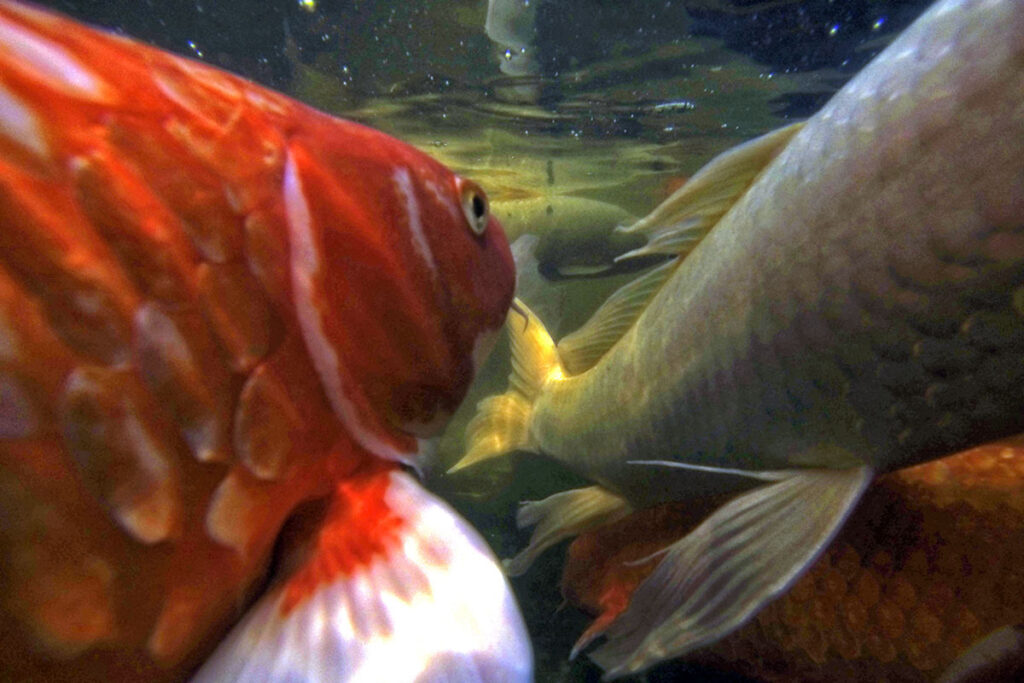
30 years of commercial photography experience has taught me that most great images weather fine art or powerful product photos share similar characteristics if they resonate with the viewer. I’ve broken these down into a simple formula I like to call the “recipe of a compelling image”.
In short, good images resonate because they have one of these four ingredients in great abundance and perhaps are supported by a few others but don’t necessarily have to contain all.

This image was shot with a GoPro that cost a few hundred bucks. It’s nothing special other than the fact that you typically look at Koi from the surface of a pond but rarely as if you are swimming with them. The point here is, if your subject is common, try and present it in an uncommon way. The natural lighting also enhances the overall tone of the image as well.
4 simple ingredients:
- Subject
- Light
- Color
- Composition
Subject
If your subject is really special (famous, unique, exotic, uncommon, presented in a unique way or otherwise spectacular) you don’t really need anything else to make it resonate. The image can even be out of focus, poorly composed or not well lit and it will still make an impact on your audience. However if your subject is average, not unique or something that is presented all the time you’ll need to be more thoughtful in your presentation and deft using your other ingredients to support such a common subject.

This image is all about light and color, as there is nothing particularly special about simply capturing an image of water and sky. I would profess that this image lacks a subject. But sometimes leaving your images void of an interest point creates an allure.
Light
Photography comes from the Greek word Photos which literally means “painting with light”. It is in fact, the essence of photography. Humans (and maybe aliens) are drawn to light. They can’t help it. The better you are at using light to support your images the better you are as a photographer. Essentially it is the main skill (or art) that makes a true pro stand out. This applies to both natural and artificial light.
Color
Next to light, people are drawn to color. The entire fashion industry depends on it. Corporate brands are completely supported by it. It’s psychological and subliminal. If you are aware of color it works like a secret ingredient like adding sugar to spaghetti sauce. If you are disregard color it may be your worst enemy. Consider color in all your messaging.
Composition
Every time you take a photo you are making a conscious decisions about what items to include or exclude and how they are arranged. It sounds simple but we know how hard it is. This encompasses a large part of the Ying or “Art” in photography as opposed to the Yang of Craft. That’s why images of the exact same subject or scene can be so very different to the viewer. COMPOSITION PRO TIP: Less is more…

If you were to arrive at a beach on a foggy January morning you might think it was a bust, but with a little thought you can make lemonade. Here a simple prop and more careful composition created a nice story and resonated with my audience. This was one of our exercises at a beachscapes photo workshop
The moral of this post is to let your camera do its job with the technical stuff and focus on what’s really important in your images.
If you are tempted to pick up your camera and take a picture, ask yourself “what do I see in this image that makes it worthy of sharing”. If I can’t be convinced that it stands out with regard to something special regarding subject, light, color or composition – I keep my camera at my side and keep walking till the next opportunity comes my way.
And sometimes it just takes a moment of thought and careful reflection to change your mind and create something truly special from seemingly nothing.



